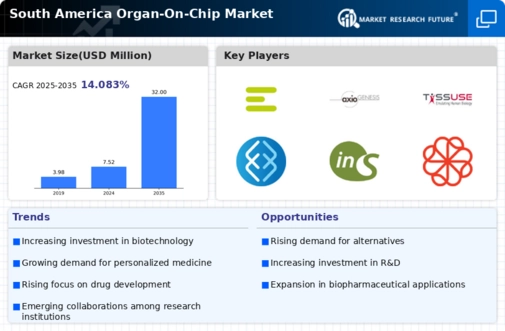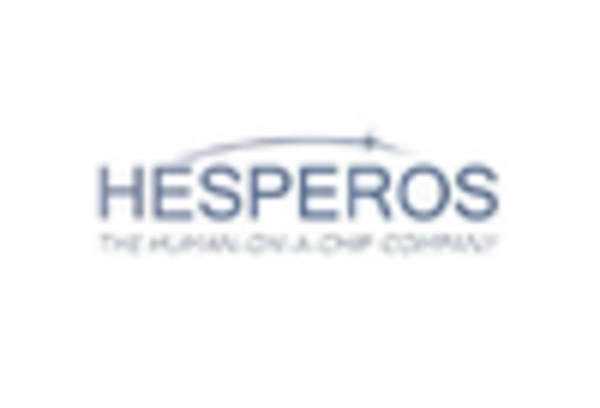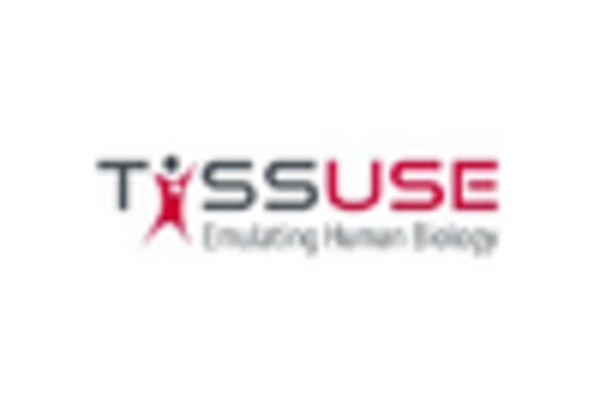Support from Government Initiatives
Government initiatives in South America are playing a crucial role in shaping the organ on-chip market. Various funding programs and grants aimed at promoting biotechnology research are being introduced, which directly benefit the development of organ-on-chip technologies. For instance, several South American countries have established biotechnology innovation funds that support research projects focused on organ-on-chip applications. This financial backing is likely to stimulate innovation and collaboration among academic institutions and private companies. As a result, the organ-on-chip market is expected to expand, with increased investment leading to advancements in technology and applications. The proactive stance of governments in fostering biotechnological advancements could significantly enhance the growth prospects of the organ-on-chip sector.
Growing Demand for Personalized Medicine
The organ on-chip market in South America is experiencing a surge in demand for personalized medicine. This trend is driven by the increasing recognition of the need for tailored therapeutic approaches that consider individual genetic and phenotypic variations. As healthcare providers and researchers seek to develop more effective treatments, organ-on-chip technologies offer a promising solution by enabling the simulation of human organ responses to various drugs. The market for personalized medicine is projected to reach approximately $2.5 billion by 2026 in South America, indicating a robust growth trajectory. This demand is likely to propel advancements in organ-on-chip technologies, as they provide critical insights into drug efficacy and safety, thereby enhancing the overall drug development process.
Advancements in Microfabrication Techniques
Recent advancements in microfabrication techniques are significantly influencing the organ on-chip market in South America. Innovations in materials science and engineering have led to the development of more sophisticated and reliable organ-on-chip models. These advancements allow for the creation of more complex tissue structures that closely mimic human physiology. As a result, researchers can conduct more accurate drug testing and disease modeling. The market for microfabrication technologies is expected to grow at a CAGR of around 15% over the next five years, which will likely benefit the organ-on-chip sector. Enhanced microfabrication capabilities not only improve the functionality of organ-on-chip devices but also reduce production costs, making them more accessible to research institutions and pharmaceutical companies.
Rising Awareness of Ethical Research Practices
The organ on-chip market in South America is witnessing a rise in awareness regarding ethical research practices. As researchers and institutions strive to minimize the use of animal testing, organ-on-chip technologies present an ethical alternative that aligns with the principles of the 3Rs: Replacement, Reduction, and Refinement. This shift towards more humane research methodologies is likely to encourage the adoption of organ-on-chip systems in academic and industrial settings. Furthermore, regulatory bodies are increasingly advocating for the use of alternative testing methods, which may further bolster the market. The ethical implications of organ-on-chip technologies could lead to a broader acceptance and integration into research protocols, thereby enhancing their market presence.
Increasing Focus on Drug Development Efficiency
The organ on-chip market in South America is being propelled by an increasing focus on drug development efficiency. Pharmaceutical companies are under pressure to reduce the time and costs associated with bringing new drugs to market. Organ-on-chip technologies provide a platform for high-throughput screening and predictive modeling, which can significantly streamline the drug discovery process. By utilizing these technologies, companies can potentially reduce the time to market by up to 30%, thereby enhancing their competitive edge. The growing need for efficient drug development processes is expected to drive investments in organ-on-chip technologies, as they offer a viable solution to the challenges faced in traditional drug testing methods.


















Leave a Comment